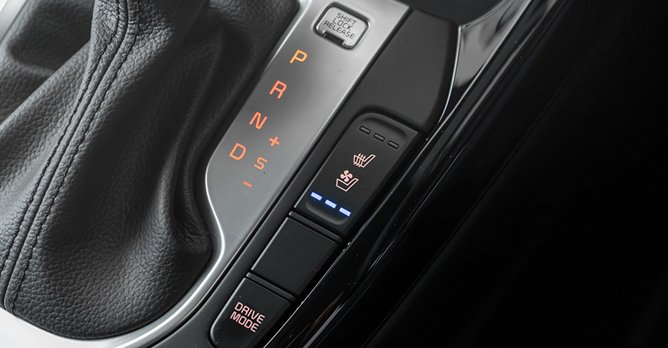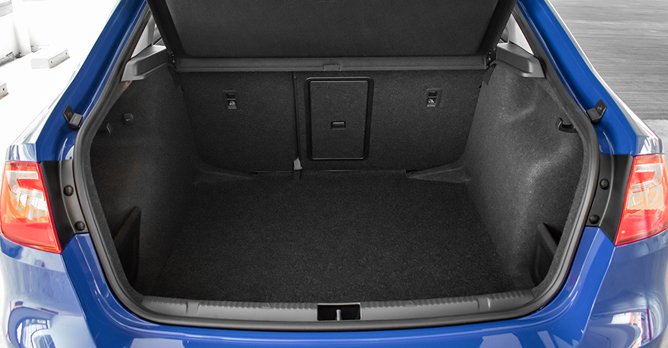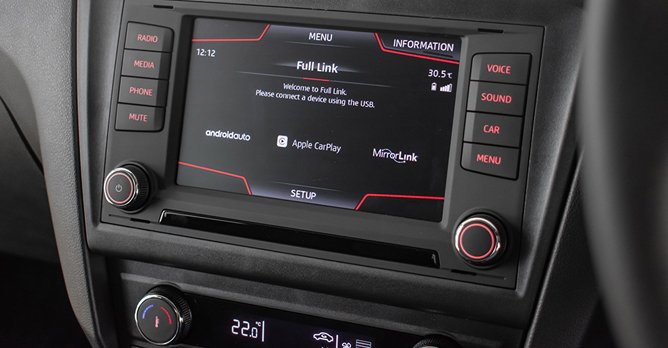Kia Cerato 1.6 GT Line vs Seat Toledo 1.4 TSI DSG Style
28 May 2019|30,084 views
Kia Cerato 1.6 GT Line
More stylish all around
Nicer cabin with better equipment
Comes with a $14,000 higher price tag
Seat Toledo 1.4 TSI DSG Style
Cheaper to buy and cheaper to run
Larger cargo space
Torquier with better fuel economy
Sedans may have been declining slightly in popularity over the last few years given the rise of the SUV, but honest offerings like the new Kia Cerato and Seat Toledo prove that the segment still has much going for it.
Whether it's sporty styling, a wealth of equipment or just good value, there's something for everyone with these two models, especially if you want something other than the typical Honda or Toyota.
And so that begs that question: If you have a budget of 80 to 100 grand, which should you go for?
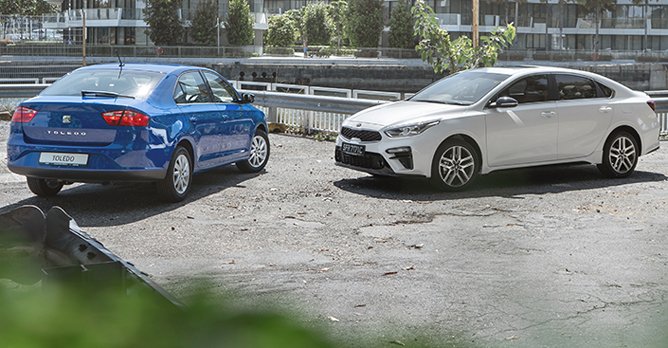
 The Toledo (left) may not be as well-furnished as the Cerato (right) but its $14,000 lower price tag is hard to ignore
The Toledo (left) may not be as well-furnished as the Cerato (right) but its $14,000 lower price tag is hard to ignore
Certified style
In GT Line specification, it's easy to see that the Cerato is the sportier-looking of the two thanks to its larger 17-inch wheels (over the Toledo's 15-inches) and more aggressively styled bumpers.
Where design is concerned, the Toledo is a lot more sedate and unfortunately looks a bit like something an Andalusian retiree would own. It also features old-ish halogen headlamps, while the Cerato gets LED ones.
And, on the inside, it's again the Cerato that has the advantage.
Its cabin is more richly appointed, with bits like a larger 8.0-inch infotainment screen (as opposed to the Toledo's 5.0-inches), paddle shifters, ventilated front seats, wireless smartphone charging and rear air-conditioning.
That said, the Cerato GT Line is admittedly (as of 27 May 2019) $14,000 more than the Toledo we tested. But, there are also three other lower-priced Cerato variants that begin from $77,999.
The Toledo does, however, have two thoughtful USB charging ports situated behind the central armrest for rear passengers, as well as a larger 550-litre boot over its Korean rival's 502 litres.
The Toledo's fastback tailgate also allows for big items to slot in more easily thanks to its wider berth.
And surprisingly, while it has a much shorter 2,470mm wheelbase (230mm shorter), legroom in the back isn't lacking and it feels just as comfortable to be in as the Cerato.
Whether it's sporty styling, a wealth of equipment or just good value, there's something for everyone with these two models, especially if you want something other than the typical Honda or Toyota.
And so that begs that question: If you have a budget of 80 to 100 grand, which should you go for?

Certified style
In GT Line specification, it's easy to see that the Cerato is the sportier-looking of the two thanks to its larger 17-inch wheels (over the Toledo's 15-inches) and more aggressively styled bumpers.
Where design is concerned, the Toledo is a lot more sedate and unfortunately looks a bit like something an Andalusian retiree would own. It also features old-ish halogen headlamps, while the Cerato gets LED ones.
And, on the inside, it's again the Cerato that has the advantage.
Its cabin is more richly appointed, with bits like a larger 8.0-inch infotainment screen (as opposed to the Toledo's 5.0-inches), paddle shifters, ventilated front seats, wireless smartphone charging and rear air-conditioning.
That said, the Cerato GT Line is admittedly (as of 27 May 2019) $14,000 more than the Toledo we tested. But, there are also three other lower-priced Cerato variants that begin from $77,999.
The Toledo does, however, have two thoughtful USB charging ports situated behind the central armrest for rear passengers, as well as a larger 550-litre boot over its Korean rival's 502 litres.
The Toledo's fastback tailgate also allows for big items to slot in more easily thanks to its wider berth.
And surprisingly, while it has a much shorter 2,470mm wheelbase (230mm shorter), legroom in the back isn't lacking and it feels just as comfortable to be in as the Cerato.
Boosted is better
However, as stylish and well packaged as the Cerato may be, it is the Toledo that feels lighter on its feet and is more fuel-efficient on the go. This is down to one major difference in their powertrains - turbocharging.
The Cerato runs a naturally aspirated 1.6-litre engine mated to a six-speed automatic, while the Toledo is powered by a Volkswagen Group turbocharged 1.4-litre paired to a seven-speed dual-clutch tranny.
Power-wise, the Cerato is rated at 126bhp and 155Nm of torque. The boosted Toledo is armed with 123bhp but 200Nm of torque.
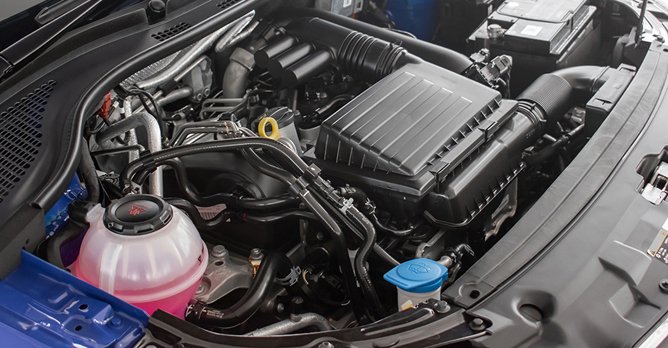
 The Toledo may not have fancy features, but it has a more modern turbocharged engine that's torquier
The Toledo may not have fancy features, but it has a more modern turbocharged engine that's torquier
This means that from 0-100km/h, the Kia takes 12 seconds while the Toledo does it in just nine. And it isn't just fluffed up marketing figures either. From the get go, the Toledo feels much lighter on its feet, with a smoother powertrain overall.
It's also more fuel efficient, easily clocking 15km/L over the same roads driven as the Cerato, which does about 10km/L.
Elsewhere, where economy is concerned, the Toledo also offers lower road taxes of $624 per annum, as opposed to the 1.6-litre Cerato's $738.
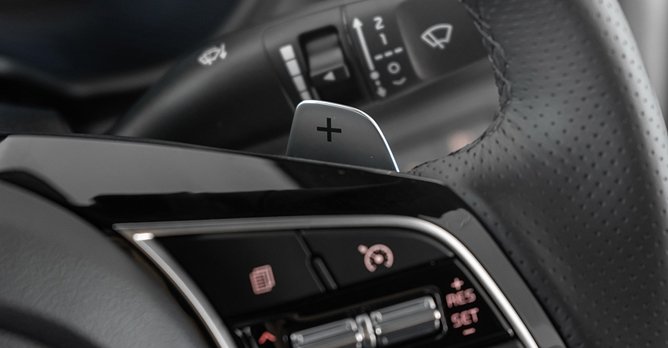
 Using the Cerato's paddle shifters doesn't offer a particularly rewarding experience but it's still a nice-to-have feature
Using the Cerato's paddle shifters doesn't offer a particularly rewarding experience but it's still a nice-to-have feature
However, that doesn't mean the Cerato completely falls behind on the road.
Its steering offers a more natural feel (the Toledo's is quite vague) and it also has a better chassis and suspension setup that handles both comfort and sporty driving better than the Toledo.
But if you can look past the Toledo's barer cabin (thankfully it still has Apple CarPlay) and slightly lumpier ride, it's still a highly viable point A to B vehicle that is $14,000 cheaper to buy and cheaper to run annually.
And... it's quicker off the lights.
However, as stylish and well packaged as the Cerato may be, it is the Toledo that feels lighter on its feet and is more fuel-efficient on the go. This is down to one major difference in their powertrains - turbocharging.
The Cerato runs a naturally aspirated 1.6-litre engine mated to a six-speed automatic, while the Toledo is powered by a Volkswagen Group turbocharged 1.4-litre paired to a seven-speed dual-clutch tranny.
Power-wise, the Cerato is rated at 126bhp and 155Nm of torque. The boosted Toledo is armed with 123bhp but 200Nm of torque.

This means that from 0-100km/h, the Kia takes 12 seconds while the Toledo does it in just nine. And it isn't just fluffed up marketing figures either. From the get go, the Toledo feels much lighter on its feet, with a smoother powertrain overall.
It's also more fuel efficient, easily clocking 15km/L over the same roads driven as the Cerato, which does about 10km/L.
Elsewhere, where economy is concerned, the Toledo also offers lower road taxes of $624 per annum, as opposed to the 1.6-litre Cerato's $738.

However, that doesn't mean the Cerato completely falls behind on the road.
Its steering offers a more natural feel (the Toledo's is quite vague) and it also has a better chassis and suspension setup that handles both comfort and sporty driving better than the Toledo.
But if you can look past the Toledo's barer cabin (thankfully it still has Apple CarPlay) and slightly lumpier ride, it's still a highly viable point A to B vehicle that is $14,000 cheaper to buy and cheaper to run annually.
And... it's quicker off the lights.
Kia Cerato 1.6 GT Line
More stylish all around
Nicer cabin with better equipment
Comes with a $14,000 higher price tag
Seat Toledo 1.4 TSI DSG Style
Cheaper to buy and cheaper to run
Larger cargo space
Torquier with better fuel economy
Sedans may have been declining slightly in popularity over the last few years given the rise of the SUV, but honest offerings like the new Kia Cerato and Seat Toledo prove that the segment still has much going for it.
Whether it's sporty styling, a wealth of equipment or just good value, there's something for everyone with these two models, especially if you want something other than the typical Honda or Toyota.
And so that begs that question: If you have a budget of 80 to 100 grand, which should you go for?

 The Toledo (left) may not be as well-furnished as the Cerato (right) but its $14,000 lower price tag is hard to ignore
The Toledo (left) may not be as well-furnished as the Cerato (right) but its $14,000 lower price tag is hard to ignore
Certified style
In GT Line specification, it's easy to see that the Cerato is the sportier-looking of the two thanks to its larger 17-inch wheels (over the Toledo's 15-inches) and more aggressively styled bumpers.
Where design is concerned, the Toledo is a lot more sedate and unfortunately looks a bit like something an Andalusian retiree would own. It also features old-ish halogen headlamps, while the Cerato gets LED ones.
And, on the inside, it's again the Cerato that has the advantage.
Its cabin is more richly appointed, with bits like a larger 8.0-inch infotainment screen (as opposed to the Toledo's 5.0-inches), paddle shifters, ventilated front seats, wireless smartphone charging and rear air-conditioning.
That said, the Cerato GT Line is admittedly (as of 27 May 2019) $14,000 more than the Toledo we tested. But, there are also three other lower-priced Cerato variants that begin from $77,999.
The Toledo does, however, have two thoughtful USB charging ports situated behind the central armrest for rear passengers, as well as a larger 550-litre boot over its Korean rival's 502 litres.
The Toledo's fastback tailgate also allows for big items to slot in more easily thanks to its wider berth.
And surprisingly, while it has a much shorter 2,470mm wheelbase (230mm shorter), legroom in the back isn't lacking and it feels just as comfortable to be in as the Cerato.
Whether it's sporty styling, a wealth of equipment or just good value, there's something for everyone with these two models, especially if you want something other than the typical Honda or Toyota.
And so that begs that question: If you have a budget of 80 to 100 grand, which should you go for?

Certified style
In GT Line specification, it's easy to see that the Cerato is the sportier-looking of the two thanks to its larger 17-inch wheels (over the Toledo's 15-inches) and more aggressively styled bumpers.
Where design is concerned, the Toledo is a lot more sedate and unfortunately looks a bit like something an Andalusian retiree would own. It also features old-ish halogen headlamps, while the Cerato gets LED ones.
And, on the inside, it's again the Cerato that has the advantage.
Its cabin is more richly appointed, with bits like a larger 8.0-inch infotainment screen (as opposed to the Toledo's 5.0-inches), paddle shifters, ventilated front seats, wireless smartphone charging and rear air-conditioning.
That said, the Cerato GT Line is admittedly (as of 27 May 2019) $14,000 more than the Toledo we tested. But, there are also three other lower-priced Cerato variants that begin from $77,999.
The Toledo does, however, have two thoughtful USB charging ports situated behind the central armrest for rear passengers, as well as a larger 550-litre boot over its Korean rival's 502 litres.
The Toledo's fastback tailgate also allows for big items to slot in more easily thanks to its wider berth.
And surprisingly, while it has a much shorter 2,470mm wheelbase (230mm shorter), legroom in the back isn't lacking and it feels just as comfortable to be in as the Cerato.
Boosted is better
However, as stylish and well packaged as the Cerato may be, it is the Toledo that feels lighter on its feet and is more fuel-efficient on the go. This is down to one major difference in their powertrains - turbocharging.
The Cerato runs a naturally aspirated 1.6-litre engine mated to a six-speed automatic, while the Toledo is powered by a Volkswagen Group turbocharged 1.4-litre paired to a seven-speed dual-clutch tranny.
Power-wise, the Cerato is rated at 126bhp and 155Nm of torque. The boosted Toledo is armed with 123bhp but 200Nm of torque.

 The Toledo may not have fancy features, but it has a more modern turbocharged engine that's torquierThis means that from 0-100km/h, the Kia takes 12 seconds while the Toledo does it in just nine. And it isn't just fluffed up marketing figures either. From the get go, the Toledo feels much lighter on its feet, with a smoother powertrain overall.
The Toledo may not have fancy features, but it has a more modern turbocharged engine that's torquierThis means that from 0-100km/h, the Kia takes 12 seconds while the Toledo does it in just nine. And it isn't just fluffed up marketing figures either. From the get go, the Toledo feels much lighter on its feet, with a smoother powertrain overall.
It's also more fuel efficient, easily clocking 15km/L over the same roads driven as the Cerato, which does about 10km/L.
Elsewhere, where economy is concerned, the Toledo also offers lower road taxes of $624 per annum, as opposed to the 1.6-litre Cerato's $738.

 Using the Cerato's paddle shifters doesn't offer a particularly rewarding experience but it's still a nice-to-have featureHowever, that doesn't mean the Cerato completely falls behind on the road.
Using the Cerato's paddle shifters doesn't offer a particularly rewarding experience but it's still a nice-to-have featureHowever, that doesn't mean the Cerato completely falls behind on the road.
Its steering offers a more natural feel (the Toledo's is quite vague) and it also has a better chassis and suspension setup that handles both comfort and sporty driving better than the Toledo.
But if you can look past the Toledo's barer cabin (thankfully it still has Apple CarPlay) and slightly lumpier ride, it's still a highly viable point A to B vehicle that is $14,000 cheaper to buy and cheaper to run annually.
And... it's quicker off the lights.
However, as stylish and well packaged as the Cerato may be, it is the Toledo that feels lighter on its feet and is more fuel-efficient on the go. This is down to one major difference in their powertrains - turbocharging.
The Cerato runs a naturally aspirated 1.6-litre engine mated to a six-speed automatic, while the Toledo is powered by a Volkswagen Group turbocharged 1.4-litre paired to a seven-speed dual-clutch tranny.
Power-wise, the Cerato is rated at 126bhp and 155Nm of torque. The boosted Toledo is armed with 123bhp but 200Nm of torque.

It's also more fuel efficient, easily clocking 15km/L over the same roads driven as the Cerato, which does about 10km/L.
Elsewhere, where economy is concerned, the Toledo also offers lower road taxes of $624 per annum, as opposed to the 1.6-litre Cerato's $738.

Its steering offers a more natural feel (the Toledo's is quite vague) and it also has a better chassis and suspension setup that handles both comfort and sporty driving better than the Toledo.
But if you can look past the Toledo's barer cabin (thankfully it still has Apple CarPlay) and slightly lumpier ride, it's still a highly viable point A to B vehicle that is $14,000 cheaper to buy and cheaper to run annually.
And... it's quicker off the lights.
Car Information
SEAT Toledo 1.4 TSI DSG Style (A)
CAT A|Petrol|20.4km/L
Horsepower
92kW (123 bhp)
Torque
200 Nm
Acceleration
9sec (0-100km /hr)
This model is no longer being sold by local distributor
All Used SEAT ToledoKia Cerato 1.6 GT Line (A)
CAT A|Petrol|15.1km/L
Horsepower
94kW (126 bhp)
Torque
155 Nm
Acceleration
12sec (0-100km /hr)
This model is no longer being sold by local distributor
All Used Kia CeratoThank You For Your Subscription.










































